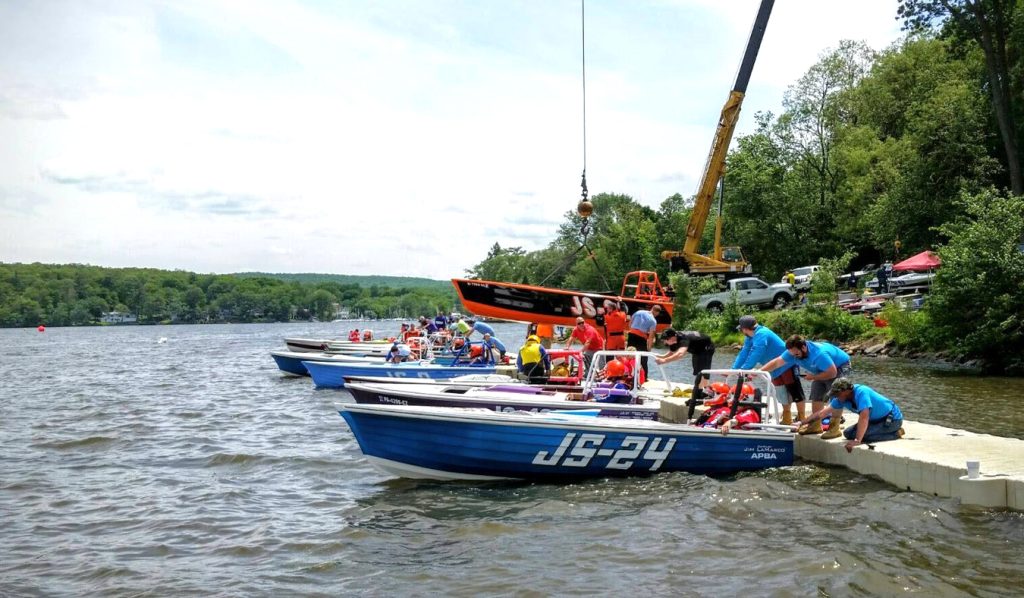An issue or two ago here on the pages of L.I.B.W., I wrote of my fondness and appreciation for sportfishing boats. They remain my favorites in what I call “Big Boats”, meaning up to 60 or so feet. Beyond that length, I’m not much interested and while I was employed by a magazine based in Fort Lauderdale that covered such things, I kinda faked it. I was on a lot of yachts 100 feet plus and all I wanted to see was the engine room. The rest to me up in the fancy places was just a bunch of fuzz. Center consoles (before they had trips, quads, or quints), pocket trawlers, picnic boats… they were more my speed. The more purposeful and compact, the better for my doubloons.
But there is one small boat in particular that I have a special affinity for. It is indeed compact, purposeful, not familiar to many and the most fun you can have with your pants on… or off. The Jersey Speed Skiff.

A close relative of the Seabright Skiffs, which proliferated along the coast after the turn of the 20th century, they originated in the Navesink and Shrewsbury (N.J.) rivers as workboats. History has it that back in 1925, one Harold “Pappy” Seaman installed a 25hp Greymarine engine in a Seabright dory and this made him the “Father of the Speed Skiff.” They no doubt played a role in smuggling hooch during prohibition and it’s equally certain that they were refined and improved out of necessity, much as were the moonshine-carrying cars that gave birth to NASCAR.
But today…
Imagine if you will, any of several super compact British sports cars like perhaps, an MG Midget, a Spitfire, or a TR4, and under their bonnet, you install a big block Chevy engine so that when you drive it, you feel like you’re just strapped to a big engine that hurtles you across the pavement. Well, that’s sorta the concept behind a modern Jersey Speed Skiff:
A mere 16-foot-long fiberglass dory-shaped shell (they were originally wooden lapstrake constructed vessels) with a flat bottom that, stripped down, barely weighs 500 pounds. Put a pair of bucket seats back against the transom and in front of that, just in the middle of the boat, drop in that big block 289 or 305 C.I.D. Chevy V8, attach it to a short shaft that terminates in a cleaver prop, the whole rig controlled by a simple sterling mechanism consisting of a steering wheel shaft that’s straight up and down like the spinner table in a teacup ride, coupled to a worm gear that rotates a single small rudder. As for the exhaust, just run the pipes off the engine headers straight back to the transom where they poke through the stern. At rest or at idle, the skiff squats down in the aft end so those open muffler-less pipes are below the waterline and you just hear a throaty gurgle, but the moment you stomp down on the gas pedal (yes, a pedal, not a throttle lever) and the boat leaps up on plane you’ll be grabbing for the ear muffs. Well, that’s a Jersey Speed Skiff.
It’s been said that the Jersey Speed Skiff is entirely unsuited to go as fast as they go and nothing truer has ever been said about a boat. Modern racing versions can exceed 90 mph, but it’s not just the speed. They typically race around a one-mile oval racecourse marked by big balloon buoys and in the straightaway the boats tend to gallop across short chop, often going airborne. In the very tight turns, they lay over on their sides, the lapstrakes of the hull side actually providing grip. Back in the “old days,” competing boats would often bang into one another in those turns, shoving one another aside and off course to gain a racing advantage. Fans of the NASCAR movie Days Of Thunder will recall race crew chief Harry ( played by William Duvall) telling rookie driver Cole Trickle (played by Tom Cruise) when he complained about being hit by another driver, “He didn’t hit you, he rubbed you, and rubbing is racing.” Well, that’s skiff racing, too.
Today, skiffs are raced all up and down the eastern seaboard. There’s not a lot of big sponsorship and they don’t always garner the amount of attention that the big offshore racers do, but man oh man, they are a blast to watch and given their shallow draught and relatively compact racecourse, you can usually get a very good shoreside seat to enjoy the action. Any sort of web search for NJ Speed Skiffs or the APBA (American Power Boat Association) will show you events and schedules in your area.
I’ll never forget my first ride in a skiff, rampaging across Barnegat Bay, exhaust thundering, spray in my face, uselessly yelling at my buddy about the engine temperature gauge, equally terrified and exhilarated, and delighting in the expressions of sudden flinching surprise on the faces of those onboard the boats we came up behind and rocketed past, using their wakes to get some air. If you ever get the opportunity to do so, DO SO! You’ll never regret it. But in the meantime, a simple search for Jersey Speed Skiffs on YouTube will yield some excellent videos including some really thrilling onboard GoPro experiences.
Copyright L.J. Wallace 2023.
Comments welcomed: Editorljwallace@gmail.com.
